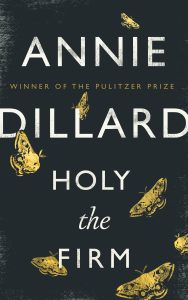To read Holy the Firm is to feel God reaching out to you through matter and literature.
 We would all be brought to our knees when looking at the face of a badly burned child or when faced with genocide statistics or a newsfeed of fatalities due to natural disasters. It’s something that sends one to prayer—the pleading type of prayer. Why? Why is this our world? Why does it have so much darkness? Can its creator and sustainer really be “good?”
We would all be brought to our knees when looking at the face of a badly burned child or when faced with genocide statistics or a newsfeed of fatalities due to natural disasters. It’s something that sends one to prayer—the pleading type of prayer. Why? Why is this our world? Why does it have so much darkness? Can its creator and sustainer really be “good?”
Annie Dillard spirals into these same questions in her extended prose poem Holy the Firm. In 1975, Dillard took up temporary residence in a cabin on the Puget Sound. Through the course of her year there, she delves into some of the most plaguing questions and renders them into a work that feels miraculous. She delves into, as she calls it, “the fringey edge where elements meet and realms mingle, where time and eternity spatter each other with foam.” Her rich prose is not a distraction, but rather a gateway into the theodicy question at hand. The aforementioned questioning is provoked by seeing the face of a little girl badly burned in a plane crash. Dillard grapples with this local horror, as well as other horrors in the world. And yet, the book is just as equally about wonder in the world as horror, giving hope and allowing readers to see the same miracles that she does. Through typical Dillard prosody in her evocations of the sheer wonder of “earthiness,” she affirms from the outset of the book that “every day is a god, each day is a god, and holiness holds forth in time.” In this book, she seeks to find a solution to her line of questioning and does it in a way that pays homage to all those in the mystic tradition before her. Because of these questions, she continually finds herself waking up to the “silence of God.” This work contains an affirmation of all that is holy in the world. Here’s an excerpt that shows that concern with holiness and beauty from Holy the Firm:
Mornings, when light spreads over the pastures like wings, and fans a secret color into everything, and beats the trees senseless with beauty, so that you can’t tell whether the beauty is in the trees –dazzling in cells like yellow sparks or green flashing waters–or on them–a transfiguring silver air charged with the wings’ invisible motion; mornings, you won’t be able to walk for the power of it: earth’s too round. And by long and waking day– Sext, None, Vespers–when the grasses, living or dead, drowse while the sun reels, or lash in any wind, when sparrows hush and tides slack at the ebb, or flood up the beaches and cliffsides tangled with weed, and hay waits, and elsewhere people buy shoes–then you kneel, clattering with thoughts, ill, or some days erupting, some days holding the altar rail, gripping the brass-bolt altar rail, so you won’t fly….
Held, held fast by love in the world like the moth in wax, your life a wick, your head on fire with prayer, held utterly, outside and in, you sleep alone, if you call that alone, you cry God.
We see Dillard approaching the world with a sacramental understanding of grace in creation. The titular phrase Holy the Firm refers to “the belief that some aspect of the material world ‘touches’ God; therefore, God is both immanent in the world yet transcends above it.” I could say the same things about this book: it touches God, it is both immanent in the world and also transcends it. To read Holy the Firm is to feel God reaching out to you through matter and literature.
-Review by Kendalyn Murdock, Inscape Staff



